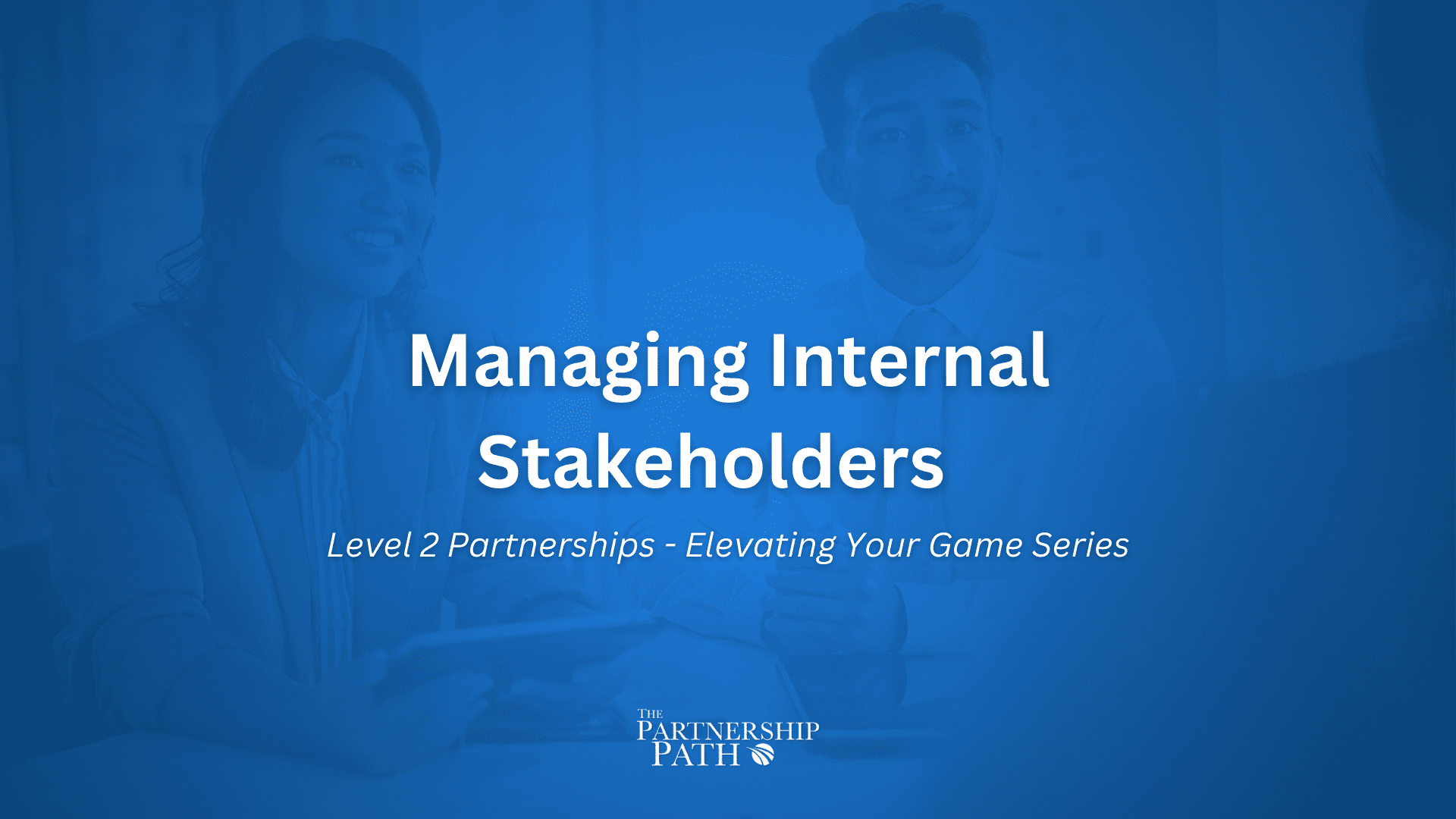Sunny Neogi at Microsoft on Co-Marketing with Partners
Episode Summary
In the latest episode of “The Partnership Path in Real Life”, John Rudow dives deep into the world of partner marketing with Sunny Niyogi, who leads Microsoft’s partner ecosystem for Healthcare and Life Sciences.
With over two decades of experience both as a partner and now within Microsoft, Sunny shares invaluable insights into the complexities and nuances of co-marketing. This conversation is a treasure trove for anyone looking to enhance their understanding of partnerships in the tech industry—making it particularly valuable for new professionals stepping into partner management roles.
Transcript
John: Sunny, welcome to the Partnership Path in Real Life. I’m so excited to have you on this episode. Just really happy to have you here. So welcome to the show.
Sunny: Thank you, John. It’s such a pleasure to be here on the show. I’m looking forward to our conversation.
John: Excellent. Well, listen, I have met you, however, most of our listeners may not have. And so I’d love to have you start by introducing yourself to our community. Tell us a little bit about your background and how long you’ve been working with partners in particular.
Sunny: Absolutely, John. So I am Sunny Niyogi. I lead up Microsoft’s Healthcare and Life Science product partner ecosystem worldwide. It’s an amazingly fun job. What I get to do is I get to work with some of the biggest healthcare companies anywhere in the world so that together with Microsoft, we can bring the best innovation to the patients and to the health systems globally, whether it be US, Uganda, and everything in between, right? So I’m very, very privileged to be in this position. I have been in this role for about two years now, but before that for 20 years, I used to be on the other side. I was a partner of Microsoft at Cognizant, at Samsung, at Aditi Technologies. I did a couple of startups, again, very closely aligned with Microsoft. So for 20 years, I’ve been on that side of the fence, two years I’m on this side of the fence. And it’s the same story. We’re all on the same mission, right? We are here to do what’s right for the patients and bring technology to help us live a better life.
So it feels like the same job, but just, it’s so much fun working with Microsoft and the partner ecosystem to make this dream come alive.
John: That’s so awesome, Sunny. I’m really anxious to hear your perspective, not just on the topic today, but just in general. I find that I learn so much from people who’ve been on the other side of the fence, right, who’ve been partners, because even though we’re on the same mission, your perspective is different, right? Like you experience a lot of the stuff we talk about in a totally different way. You’re the recipient or sometimes the casualty of kind of what sometimes we do as vendors, right? And so I can’t wait to hear your perspective. So let’s jump in. You know that this episode is really about co-marketing with partners. And you’re here because you listened to the episode Tony and I just did. So let’s start there. Tell me a little bit about kind of what struck you in that episode when Tony and I were talking.
Sunny: I’ll connect that with some of my own experience. So the fun, you know, fun story, sidebar story here is that I was a, I’m a recovering chief marketing officer. I was a CMO for about five to six years. Right. And, you know, I essentially started my life in marketing from, you know, very much like Tony, I grew through telehealth and telesales as to call down prospects. My first job out of college was to get market research done, standing in the street, talking to consumers. Right. And then, you know, I grew and I was leading up marketing for a large business quite a few times. So just some of the things you talked about, I think when it comes to marketing, there are certain things that resonated very strongly with me. The first and foremost bit is just being on the same page about what marketing should do. That definition changes widely from business to business. But at the end of the day, the answer is very simple. And everybody understands that question, is that marketing’s role is to position ourselves to the needs of the customer and serve that need at the point in time when they have that need, right? You can measure it by revenue. You can measure it by, you know, free downloads. It really doesn’t matter as long as, you know, customer need is being serviced by you before the sales team comes in or even sometimes scaling the sales team. There’s a lot of marketing-led organization where sales is more like customer success, right? So, you know, those boundaries might blur. So I think, you know, centering on that core truth saying, our job is to shine a unique light on what we can do for our customers. And beneath that, two, three very simple things again, is one is deeply understanding what the customer really needs and wants and how you are uniquely positioned to do that. And sometimes we get so caught up in the complexities and the creativity and the fun part of marketing. And I love marketing because of that. Don’t get me wrong. That’s why I enjoy marketing. But the job of marketing is to be crisp about that.
And then really be disciplined over many, many, many days, years, quarters, not seeing different things, seeing the same thing over and over again, once you know what works. Right. And that answer is rooted in why did customers buy from me? Right. Why did they choose me or anybody else? Why did they choose me at that point in time? Why did they choose to pay me $1 or $2? Right. I think once you figure that out, just doing that same thing consistently over time is the true, true north of marketing. Right. Yes, there’s a lot of creativity. There’s a lot of collaboration with sales, all those are fun parts of the job. But at the core of it, that job is very simple. So I really liked your conversation with the other guest and talking about what we can do together.
John: Well, so Sunny, you key in for me, you key in on one of the biggest challenges of marketing with partners, right? Which is, I don’t think all organizations, well, I guess if I start at the high level, not all organizations have that same definition of what marketing’s purpose is. And more importantly, when you get down into individuals within the organization, sometimes the people you’re working with at the partner don’t have an appreciation for what marketing is really supposed to do. And so how do you bridge that? Like you’ve been on both sides. So when you were a partner, you had that marketing background, you got it. But now as a PDM for Microsoft, how do you bridge that gap sometimes? Like what do you do with your partners to help them understand the right way to go to market together from a marketing perspective?
Sunny: Mm-hmm. That’s a great question, John. In my current role, I work with Microsoft’s largest partners that do about $10 to $20 billion of revenue individually. So they are all very well-established market leaders. So they know very clearly how to reach their customers, how to position themselves to win competitive conversations, etc. In my prior life, as I said, I have done a couple of startups when I was a commercial leader, and then I’ve been part of a very large organization where we were in marketing. If I contrast those two endpoints, right? Clearly a Samsung or a Cognizant knows how to market, knows how to market with partners. They have very, very evolved, mature sales teams, right? And marketing teams. A startup on the other end, there is zero personal marketing. The marketing person is also doing cultural events internally, writing content for the audience, doing internal demos. You wear so many hats, right? I think the key distinction I see… John is less about maturity. It’s not like small companies don’t have great people. It’s that those great people are burdened with a lot of things to do. So the distinction between a very mature company and a small company is not really marketing maturity, but figuring out what you should focus on. So let me elaborate on that a little bit. Say if you are a very large market leader, your core objective for partner marketing is not so much to get in front of new accounts. If you’re a $10 billion business in the business for 50 years, all your prospects know about you. They know clearly what you do, what you don’t, and whether you’re good, whether you’re not. But the real value there is in either increasing the conversion rate of your pursuits together, saying, hey, Microsoft brings in certain brand attributes, whether it be trust, whether it be enterprise coverage, and I, as a partner, bring in complementary brand attributes that position us to win more deals. So you change your conversion rates significantly, not deals, but conversion rate. Sometimes it’s also about conversion time, right? Saying together the customer might be asking me 30 questions. If I bring in Microsoft, Microsoft can address 15 of them. And together we can close the deal faster, right? So I think your matrix in the funnel changes if you’re a big and mature company. While when I was a startup marketing leader and a sales leader, my objective with the Microsoft Partner Marketing was very simple. I wanted people to hear about me. I was a nobody. Everybody knows Microsoft. So I wanted to jump on Microsoft’s coattail and show up with the right customers. So it was more of a top-of-the-funnel focus for me. It was a branding focus. It was above-the-line marketing focus. So I think those objectives change depending on the scale of the business. But I can assure you that there are incredibly good and strong marketing leaders in smaller companies. And I would argue that, you know, pound for pound, some of the smaller companies out-market some of the big companies. And that’s how technology works. These startups become market leaders, which is why it’s fun.
John
That’s true. Yeah. Yeah. Well, so let’s explore that then too, which is, I think that there are not very many PDMs. There’s not very many channel managers, partner managers, whatever the title is, who have a marketing background like you do. And so this concept of maybe not knowing exactly how to tackle those situations, really looking at it as a matrix, right? Like what’s the nuance that we need to do together?
Sunny
Mm-hmm.
John
It’s intimidating for certain channel managers and partner managers, right? So what’s your advice to them? If someone’s coming into this role and they don’t have a marketing background, what’s your advice to them to kind of step into that with a certain amount of confidence?
Sunny
Great question, John. And I have one of those favorite stories I heard long back from one of my friends in marketing. He said, anybody you ask in the world has an opinion on two things, which fast food chain has the best French fries and what a company should do with marketing. Like everybody has an opinion on that, right? So I take that as a strength because instinctively all of us understand what marketing is, right? It’s about telling a cool story. It’s about touching your heartstrings. It’s about making you take an action, right?
So my comment to PDNs who don’t have a marketing background is you already know it, you already feel it. The car you bought, you bought it because of marketing, right? You got this, right? So that’s step number one. So don’t be intimidated, right? Compared to say corporate accounting, right? Where you really, really need to understand the minutia of things. You can approach marketing as a human being, right? Saying, I exist, I breathe, I have response to stimulus, I get marketing at a very fundamental level, right? So the next question is saying, how do I take that general sense and put that on a framework that helps me get better over time and helps me drive to an outcome? How do I get structured around that thinking?
The video that I saw that I am a very, very proud student of yours, John. I think you did a phenomenal job of laying out the foundational pieces, saying that marketing has multiple purposes. Understand where you’re in the sales cycle, what you’re trying to do with your audience. So getting that framework is very valuable to be slightly more intelligent about how we generally opine about marketing. I don’t want anybody to stop opining, but I want them to kind of understand where they’re coming at, what they’re coming at. So I think that would be my first principle. My second principle is when we talk about marketing and marketing, go to market, again, these are very big terms. These can mean a lot of things. These are very complex things.
John
Right, right.
Sunny
My basic definition is go to market is get to money. It’s, you know, GTM means get to money, right? Figure out where customers are buying, why they are buying, right? Figure that out at a very data-driven cut level so that everybody understands that songbook like in their bones, right? Once you get that, just get bloody good at doing it over and over. Don’t give up, right? You know, you are talking about human behavior change, right?
John
Yep, yep.
Sunny
Anybody who has a kid knows that it takes about 30 years for the kids to listen to their dad and mom, right? So it takes 30 years for a human being to listen, right? It’s the same thing for customers. Don’t give up, right? Quarter on quarter, your metrics might look sideways. Don’t give up a marketing campaign because you are 5% behind target. That’s a silly way of thinking about human behavior change. Take a five-year view. Take a five-quarter view. As long as the curve is sloping up to the right, you are on the right track, right? And if you’re not, be pretty fearless about saying this is not working, right? You know, I have a framework, the framework works, I have an instinct, I trust my instinct. This thing is not working, it’s a thing, it’s not me, right? So I think just having that humility, clarity, and simplicity of saying, I don’t get it, and I’m going to get better at it, or I got it, I’m not going to give up on it, I think that will be a guidance. Stay at it.
John
Yeah. Yeah. I love that. I love that perspective, Sunny. I spend so much time talking to partner managers, channel managers, whatever, about how much more they know than they think they do. Right. That in the job you guys are in, you have this unique ability or this unique advantage of having worked with lots of different companies in lots of different ways. And so even though you may not be a marketing expert, you’ve actually seen marketing work in more ways than most marketing people get to see in their normal careers, because they only work for a few organizations over their career. You, as a partner manager, actually work with many organizations at the same time. Right? So you, there’s this element of…
Sunny
Yeah. Yeah.
John
You actually know way more than you think you do. It’s just a matter of maybe building that confidence, as you said, to trust your gut a little bit, looking for a framework that you can follow so that you can put some language to what you’re doing. But you probably know more than you think you do. And like you said, it’s not like marketing is super complicated. It’s not that complicated, but sometimes it can be intimidating. And so we just have to help people over that hump a little bit, yeah?
Sunny
Absolutely, John. Yeah.
John
Yeah. Listen, Sunny, this has been great. We’re at time. So let me just do one last thing. We have lots of people who listen to the podcast who are relatively new to partner management roles. So in the topic of marketing, what’s your kind of one piece of advice that you’d give to somebody who’s brand new to working with partners? Like anything at all, what would you give them?
Sunny
That’s such a lovely question to end the conversation on, John. You know, I, and I have spent a lot of time in partnership development on both sides, right? You know, to me, partnership, and I’ve been at it for 22 years almost, right? So it’s been longer than I’ve been married, right? But partnership is like marriage. And what that means is, you know, you should be comfortable saying what you truly desire. Right? If you need something from a partner saying, look, I am behind in this market or I’m losing too many deals.
John
Yeah. Yeah.
Sunny
Be upfront and honest about it. Actually, both together, we can solve for that. It could be Microsoft losing market share in a specific segment where I really need a partner leaning with me for my own brand. The partner might have a stronger brand than Microsoft. My perspective is don’t be shy about it. Unless you acknowledge that you are behind, you will never get ahead. Like marriage, you’ve got to have honesty in that relationship. You’ve got to say, I am here, I want to go here, but I can only do so much. Can you do me a little bit more? Together can we get closer to that, right? I think that honesty, that truth has to be there, right? Because it’s not a transactional thing, right? It’s not saying, I got $50,000 more from this partner for home marketing this quarter. That’s a silly way of thinking about partner marketing, right? A, it’s a three to five year journey to change people’s mind. B, we are not getting off our bed to get extra dollars in partner marketing fund, which is, it helps, but that’s not the point of it. The point is saying, I need to do this new thing, can you help me?
So that’s, I think, one advice. The second advice for me is, like marriage, right? You need to renew your vows ever so often. In technology, it is even more important, right? Because our worldview shifts every two to three years, right? Yesterday it was cloud, today it’s going to be AI. Day after tomorrow, it may be AGI, who knows, right? But as long as we renew ourselves in that quest, saying, look, I am dominating this market. And marketing has figured out a new target market to go after, which is, by the way, holy grail for any CMO. If you can open up new addressable market, it is far more valuable to anybody than increasing percentage point of a pipeline stage, right? Any of those things, right? As businesses change, as realities change, how do we communicate? How do we keep up with each other? Do we sit down with our marketing teams on both sides and say, look, my goalposts have shifted? Things that I used to care about a lot two months ago are table stakes for me now.
John
Yep. Yep.
Sunny
I need to go do this new thing, right? So I think, you know, thinking of this as a marriage, John, would be my, you know, simple advice, saying, be honest, what do you want? And, you know, just hug each other once in a while, go for happy hours, have fun doing it, right? It’s a lovely…
John
I love it. I love it. I think I’m gonna steal that, Sunny. I’m gonna go back to some of our earliest, you know, when we first introduced partnership as a concept. I’m gonna go back and use that analogy. I love that a lot. Sunny, thanks so much. Yep, thanks so much for coming on the show with me. I really appreciate it. And I’d like to have you back again sometime soon. We’ll talk about something else in partnership that is similar to marriage as well. I love it.
Sunny
I can’t wait to see it in the conference. Thank you for having me, John, looking forward to it. Have a lovely day. Bye.
John
Thanks, Sunny. Bye-bye.
Key Takeaways
- Understanding Customer Needs: Successful marketing hinges on clearly understanding customer needs and positioning offers to meet them effectively.
- The Relationship Metaphor: Partnerships should be treated like marriages—honesty and continual communication are essential.
- Long-term Perspective: Marketing is a long-term game; metrics may fluctuate, but consistent messaging and execution lead to success.



